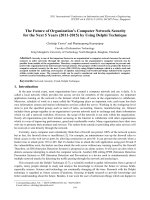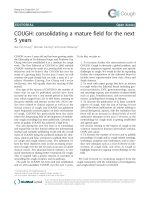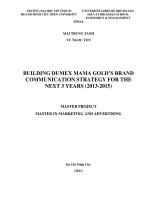The next 100 years a forecast for the 21 century
Bạn đang xem bản rút gọn của tài liệu. Xem và tải ngay bản đầy đủ của tài liệu tại đây (7.89 MB, 273 trang )
i
d
.
o
y
u
n
e
m
S
ti h
g
N
u
t
S
i
d
.
o
n
e
u
t
S
y
u
ti h
m
S
g
N
This book has been optimized for viewing
at a monitor setting of 1024 x 768 pixels.
i
d
.
o
THE NEXT 100 YEARS
y
u
n
e
m
S
ti h
g
N
u
t
S
A l s o b y Ge o rg e Fr i e d m a n
AMERICA’S SECRET WAR
The Future of War
n
e
THE INTELLIGENCE EDGE
i
d
u
t
S
THE COMING WAR WITH JAPAN
y
u
POLITICAL PHILOSOPHY OF THE FRANKFURT SCHOOL
m
S
ti h
g
N
.
o
.
o
THE
N E X T
di
u
t
1 0 0
S
n
Y E AyeR S
u
g
N
ti h
A F O R E CA ST F O R TH E 21ST C E NTU RY
m
S
Ge o rg e Fr i e d m a n
Doubleday
NEW YORK
LON DON
TORONTO
SYDNEY
AUCKLAND
.
o
Copyright © 2009 by George Friedman
i
d
All Rights Reserved
Published in the United States by Doubleday,
an imprint of The Doubleday Publishing Group,
a division of Random House, Inc., New York.
www.doubleday.com
u
t
S
doubleday and the DD colophon are registered trademarks of
Random House, Inc.
n
e
All maps created by Stratfor
Book design by Elizabeth Rendfleisch
y
u
Library of Congress Cataloging-in-Publication Data
Friedman, George.
The next 100 years : a forecast for the 21st century / George Friedman. —
1st ed.
p. cm.
1. International relations—21st century. 2. Twenty-first century—
Forecasts. 3. World politics—21st century—Forecasting. 4. International
relations—Forecasting. I. Title. II. Title: Next hundred years.
JZ1305.F75 2009
303.49—dc22
2008026423
m
S
ti h
g
N
eISBN: 978-0-385-52294-6
v1.0
y
u
n
e
m
S
ti h
g
N
i
d
u
t
S
For Meredith, muse and taskmaster
.
o
i
d
.
o
y
u
n
e
m
S
ti h
g
N
u
t
S
i
d
.
o
u
t
S
To him who looks upon the world rationally, the world in
turn presents a rational aspect. The relation is mutual.
—George W. F. Hegel
y
u
n
e
m
S
ti h
g
N
i
d
.
o
y
u
n
e
m
S
ti h
g
N
u
t
S
CONTENTS
n
e
i
d
u
t
S
y
u
list of illustrations
xi
author’s note
xiii
g
N
Overture: An Introduction to the American Age
1
ti h
CHAPTER 1
The Dawn of the American Age
15
m
S
CHAPTER 2
Earthquake: The U.S.–Jihadist War
31
CHAPTER 3
Population, Computers, and Culture Wars
50
CHAPTER 4
The New Fault Lines
65
.
o
x
contents
CHAPTER 5
China 2020: Paper Tiger
88
CHAPTER 6
Russia 2020: Rematch
101
American Power and the Crisis of 2030
120
CHAPTER 8
A New World Emerges
136
n
e
CHAPTER 9
u
t
S
The 2040s: Prelude to War
153
y
u
g
N
CHAPTER 10
Preparing for War
174
ti h
m
S
CHAPTER 11
World War: A Scenario
193
CHAPTER 12
The 2060s: A Golden Decade
212
CHAPTER 13
2080: The United States, Mexico,
and the Struggle for the Global Heartland
223
epilogue
249
acknowledgments
255
.
o
i
d
CHAPTER 7
y
u
n
e
Atlantic Europe
The Soviet Empire
Yugoslavia and the Balkans
Earthquake Zone
Islamic World—Modern
U.S. River System
South America: Impassable Terrain
Pacific Trade Routes
Successor States to the Soviet Union
Ukraine’s Strategic Significance
Four Europes
Turkey in 2008
Ottoman Empire
Mexico Prior to Texas Rebellion
China: Impassable Terrain
China’s Population Density
Silk Road
The Caucasus
Central Asia
Poacher’s Paradise
m
S
ti h
g
N
i
d
u
t
S
List of Illustrations
.
o
20
25
33
35
36
41
43
67
71
72
75
81
82
85
89
90
91
108
110
137
xii
l i s t o f i l l u s t r at i o n s
Japan
Middle East Sea Lanes
Poland 1660
The Skagerrak Straits
Turkish Sphere of Influence 2050
U.S. Hispanic Population (2000)
Levels of Economic and Social Development
Mexican Social and Economic Development
y
u
n
e
m
S
ti h
g
N
140
158
161
162
203
226
233
234
u
t
S
i
d
.
o
author’s note
y
u
n
e
.
o
u
t
S
i
d
I have no crystal ball. I do, however, have a method that has served me well,
imperfect though it might be, in understanding the past and anticipating
the future. Underneath the disorder of history, my task is to try to see the
order—and to anticipate what events, trends, and technology that order will
bring forth. Forecasting a hundred years ahead may appear to be a frivolous
activity, but, as I hope you will see, it is a rational, feasible process, and it is
hardly frivolous. I will have grandchildren in the not-distant future, and
some of them will surely be alive in the twenty-second century. That thought
makes all of this very real.
In this book, I am trying to transmit a sense of the future. I will, of
course, get many details wrong. But the goal is to identify the major
tendencies—geopolitical, technological, demographic, cultural, military—
in their broadest sense, and to define the major events that might take place.
I will be satisfied if I explain something about how the world works today,
and how that, in turn, defines how it will work in the future. And I will be
delighted if my grandchildren, glancing at this book in 2100, have reason to
say, “Not half bad.”
m
S
ti h
g
N
i
d
.
o
y
u
n
e
m
S
ti h
g
N
u
t
S
i
d
.
o
THE NEXT 100 YEARS
y
u
n
e
m
S
ti h
g
N
u
t
S
i
d
.
o
y
u
n
e
m
S
ti h
g
N
u
t
S
O V E RT U R E
.
o
u
t
S
i
d
An Introduction to the American Age
y
u
n
e
magine that you were alive in the summer of 1900, living in London,
then the capital of the world. Europe ruled the Eastern Hemisphere.
There was hardly a place that, if not ruled directly, was not indirectly
controlled from a European capital. Europe was at peace and enjoying un
precedented prosperity. Indeed, European interdependence due to trade
and investment was so great that serious people were claiming that war had
become impossible—and if not impossible, would end within weeks of be
ginning—because global financial markets couldn’t withstand the strain.
The future seemed fixed: a peaceful, prosperous Europe would rule the
world.
Imagine yourself now in the summer of 1920. Europe had been torn apart
by an agonizing war. The continent was in tatters. The Austro-Hungarian,
Russian, German, and Ottoman empires were gone and millions had died
in a war that lasted for years. The war ended when an American army of a
million men intervened—an army that came and then just as quickly left.
Communism dominated Russia, but it was not clear that it could survive.
Countries that had been on the periphery of European power, like the
United States and Japan, suddenly emerged as great powers. But one thing
I
m
S
ti h
g
N
2
the next 100 years
was certain—the peace treaty that had been imposed on Germany guaran
teed that it would not soon reemerge.
Imagine the summer of 1940. Germany had not only reemerged but
conquered France and dominated Europe. Communism had survived and
the Soviet Union now was allied with Nazi Germany. Great Britain alone
stood against Germany, and from the point of view of most reasonable peo
ple, the war was over. If there was not to be a thousand-year Reich, then cer
tainly Europe’s fate had been decided for a century. Germany would
dominate Europe and inherit its empire.
Imagine now the summer of 1960. Germany had been crushed in the
war, defeated less than five years later. Europe was occupied, split down the
middle by the United States and the Soviet Union. The European empires
were collapsing, and the United States and Soviet Union were competing
over who would be their heir. The United States had the Soviet Union
surrounded and, with an overwhelming arsenal of nuclear weapons, could
annihilate it in hours. The United States had emerged as the global super
power. It dominated all of the world’s oceans, and with its nuclear force
could dictate terms to anyone in the world. Stalemate was the best the Sovi
ets could hope for—unless the Soviets invaded Germany and conquered
Europe. That was the war everyone was preparing for. And in the back
of everyone’s mind, the Maoist Chinese, seen as fanatical, were the other
danger.
Now imagine the summer of 1980. The United States had been defeated
in a seven-year war—not by the Soviet Union, but by communist North
Vietnam. The nation was seen, and saw itself, as being in retreat. Expelled
from Vietnam, it was then expelled from Iran as well, where the oil fields,
which it no longer controlled, seemed about to fall into the hands of the So
viet Union. To contain the Soviet Union, the United States had formed an
alliance with Maoist China—the American president and the Chinese
chairman holding an amiable meeting in Beijing. Only this alliance seemed
able to contain the powerful Soviet Union, which appeared to be surging.
Imagine now the summer of 2000. The Soviet Union had completely
collapsed. China was still communist in name but had become capitalist in
practice. NATO had advanced into Eastern Europe and even into the for
mer Soviet Union. The world was prosperous and peaceful. Everyone knew
i
d
.
o
y
u
n
e
m
S
ti h
g
N
u
t
S
overture
3
that geopolitical considerations had become secondary to economic consid
erations, and the only problems were regional ones in basket cases like Haiti
or Kosovo.
Then came September 11, 2001, and the world turned on its head again.
At a certain level, when it comes to the future, the only thing one can be
sure of is that common sense will be wrong. There is no magic twenty-year
cycle; there is no simplistic force governing this pattern. It is simply that the
things that appear to be so permanent and dominant at any given moment
in history can change with stunning rapidity. Eras come and go. In interna
tional relations, the way the world looks right now is not at all how it will
look in twenty years . . . or even less. The fall of the Soviet Union was hard
to imagine, and that is exactly the point. Conventional political analysis suf
fers from a profound failure of imagination. It imagines passing clouds to be
permanent and is blind to powerful, long-term shifts taking place in full
view of the world.
If we were at the beginning of the twentieth century, it would be impos
sible to forecast the particular events I’ve just listed. But there are some
things that could have been—and, in fact, were—forecast. For example, it
was obvious that Germany, having united in 1871, was a major power in an
insecure position (trapped between Russia and France) and wanted to re
define the European and global systems. Most of the conflicts in the first
half of the twentieth century were about Germany’s status in Europe. While
the times and places of wars couldn’t be forecast, the probability that there
would be a war could be and was forecast by many Europeans.
The harder part of this equation would be forecasting that the wars
would be so devastating and that after the first and second world wars were
over, Europe would lose its empire. But there were those, particularly after
the invention of dynamite, who predicted that war would now be cata
strophic. If the forecasting on technology had been combined with the fore
casting on geopolitics, the shattering of Europe might well have been
predicted. Certainly the rise of the United States and Russia was predicted
in the nineteenth century. Both Alexis de Tocqueville and Friedrich Niet
zsche forecast the preeminence of these two countries. So, standing at the
beginning of the twentieth century, it would have been possible to forecast
its general outlines, with discipline and some luck.
i
d
.
o
y
u
n
e
m
S
ti h
g
N
u
t
S
4
the next 100 years
the t went y-first century
Standing at the beginning of the twenty-first century, we need to identify
the single pivotal event for this century, the equivalent of German unifica
tion for the twentieth century. After the debris of the European empire is
cleared away, as well as what’s left of the Soviet Union, one power remains
standing and overwhelmingly powerful. That power is the United States.
Certainly, as is usually the case, the United States currently appears to be
making a mess of things around the world. But it’s important not to be con
fused by the passing chaos. The United States is economically, militarily,
and politically the most powerful country in the world, and there is no real
challenger to that power. Like the Spanish-American War, a hundred years
from now the war between the United States and the radical Islamists will
be little remembered regardless of the prevailing sentiment of this time.
Ever since the Civil War, the United States has been on an extraordinary
economic surge. It has turned from a marginal developing nation into an
economy bigger than the next four countries combined. Militarily, it has
gone from being an insignificant force to dominating the globe. Politically,
the United States touches virtually everything, sometimes intentionally and
sometimes simply because of its presence. As you read this book, it will seem
that it is America-centric, written from an American point of view. That
may be true, but the argument I’m making is that the world does, in fact,
pivot around the United States.
This is not only due to American power. It also has to do with a funda
mental shift in the way the world works. For the past five hundred years,
Europe was the center of the international system, its empires creating a sin
gle global system for the first time in human history. The main highway to
Europe was the North Atlantic. Whoever controlled the North Atlantic
controlled access to Europe—and Europe’s access to the world. The basic
geography of global politics was locked into place.
Then, in the early 1980s, something remarkable happened. For the first
time in history, transpacific trade equaled transatlantic trade. With Europe
reduced to a collection of secondary powers after World War II, and the
shift in trade patterns, the North Atlantic was no longer the single key to
anything. Now whatever country controlled both the North Atlantic and
i
d
.
o
y
u
n
e
m
S
ti h
g
N
u
t
S
overture
5
the Pacific could control, if it wished, the world’s trading system, and there
fore the global economy. In the twenty-first century, any nation located on
both oceans has a tremendous advantage.
Given the cost of building naval power and the huge cost of deploying it
around the world, the power native to both oceans became the preeminent
actor in the international system for the same reason that Britain dominated
the nineteenth century: it lived on the sea it had to control. In this way,
North America has replaced Europe as the center of gravity in the world,
and whoever dominates North America is virtually assured of being the
dominant global power. For the twenty-first century at least, that will be the
United States.
The inherent power of the United States coupled with its geographic po
sition makes the United States the pivotal actor of the twenty-first century.
That certainly doesn’t make it loved. On the contrary, its power makes it
feared. The history of the twenty-first century, therefore, particularly the
first half, will revolve around two opposing struggles. One will be secondary
powers forming coalitions to try to contain and control the United States.
The second will be the United States acting preemptively to prevent an ef
fective coalition from forming.
If we view the beginning of the twenty-first century as the dawn of the
American Age (superseding the European Age), we see that it began with a
group of Muslims seeking to re-create the Caliphate—the great Islamic em
pire that once ran from the Atlantic to the Pacific. Inevitably, they had to
strike at the United States in an attempt to draw the world’s primary power
into war, trying to demonstrate its weakness in order to trigger an Islamic
uprising. The United States responded by invading the Islamic world. But
its goal wasn’t victory. It wasn’t even clear what victory would mean. Its goal
was simply to disrupt the Islamic world and set it against itself, so that an Is
lamic empire could not emerge.
The United States doesn’t need to win wars. It needs to simply disrupt
things so the other side can’t build up sufficient strength to challenge it. On
one level, the twenty-first century will see a series of confrontations involv
ing lesser powers trying to build coalitions to control American behavior
and the United States’ mounting military operations to disrupt them. The
twenty-first century will see even more war than the twentieth century, but
i
d
.
o
y
u
n
e
m
S
ti h
g
N
u
t
S
6
the next 100 years
the wars will be much less catastrophic, because of both technological
changes and the nature of the geopolitical challenge.
As we’ve seen, the changes that lead to the next era are always shockingly
unexpected, and the first twenty years of this new century will be no excep
tion. The U.S.–Islamist war is already ending and the next conflict is in
sight. Russia is re-creating its old sphere of influence, and that sphere of in
fluence will inevitably challenge the United States. The Russians will be
moving westward on the great northern European plain. As Russia recon
structs its power, it will encounter the U.S.-dominated NATO in the three
Baltic countries—Estonia, Latvia, and Lithuania—as well as in Poland.
There will be other points of friction in the early twenty-first century, but
this new cold war will supply the flash points after the U.S.–Islamist war
dies down.
The Russians can’t avoid trying to reassert power, and the United States
can’t avoid trying to resist. But in the end Russia can’t win. Its deep internal
problems, massively declining population, and poor infrastructure ulti
mately make Russia’s long-term survival prospects bleak. And the second
cold war, less frightening and much less global than the first, will end as the
first did, with the collapse of Russia.
There are many who predict that China is the next challenger to the
United States, not Russia. I don’t agree with that view for three reasons.
First, when you look at a map of China closely, you see that it is really a very
isolated country physically. With Siberia in the north, the Himalayas and
jungles to the south, and most of China’s population in the eastern part of
the country, the Chinese aren’t going to easily expand. Second, China has
not been a major naval power for centuries, and building a navy requires a
long time not only to build ships but to create well-trained and experi
enced sailors.
Third, there is a deeper reason for not worrying about China. China is
inherently unstable. Whenever it opens its borders to the outside world, the
coastal region becomes prosperous, but the vast majority of Chinese in the
interior remain impoverished. This leads to tension, conflict, and instability.
It also leads to economic decisions made for political reasons, resulting in
inefficiency and corruption. This is not the first time that China has opened
itself to foreign trade, and it will not be the last time that it becomes unsta
i
d
.
o
y
u
n
e
m
S
ti h
g
N
u
t
S
overture
7
ble as a result. Nor will it be the last time that a figure like Mao emerges to
close the country off from the outside, equalize the wealth— or poverty—
and begin the cycle anew. There are some who believe that the trends of the
last thirty years will continue indefinitely. I believe the Chinese cycle will
move to its next and inevitable phase in the coming decade. Far from being
a challenger, China is a country the United States will be trying to bolster
and hold together as a counterweight to the Russians. Current Chinese eco
nomic dynamism does not translate into long-term success.
In the middle of the century, other powers will emerge, countries that
aren’t thought of as great powers today, but that I expect will become more
powerful and assertive over the next few decades. Three stand out in partic
ular. The first is Japan. It’s the second-largest economy in the world and the
most vulnerable, being highly dependent on the importation of raw materi
als, since it has almost none of its own. With a history of militarism, Japan
will not remain the marginal pacifistic power it has been. It cannot. Its own
deep population problems and abhorrence of large-scale immigration will
force it to look for new workers in other countries. Japan’s vulnerabilities,
which I’ve written about in the past and which the Japanese have managed
better than I’ve expected up until this point, in the end will force a shift in
policy.
Then there is Turkey, currently the seventeenth-largest economy in the
world. Historically, when a major Islamic empire has emerged, it has been
dominated by the Turks. The Ottomans collapsed at the end of World War
I, leaving modern Turkey in its wake. But Turkey is a stable platform in the
midst of chaos. The Balkans, the Caucasus, and the Arab world to the south
are all unstable. As Turkey’s power grows—and its economy and military are
already the most powerful in the region—so will Turkish influence.
Finally there is Poland. Poland hasn’t been a great power since the six
teenth century. But it once was—and, I think, will be again. Two factors
make this possible. First will be the decline of Germany. Its economy is large
and still growing, but it has lost the dynamism it has had for two centuries.
In addition, its population is going to fall dramatically in the next fifty
years, further undermining its economic power. Second, as the Russians
press on the Poles from the east, the Germans won’t have an appetite for a
third war with Russia. The United States, however, will back Poland, pro
i
d
.
o
y
u
n
e
m
S
ti h
g
N
u
t
S









